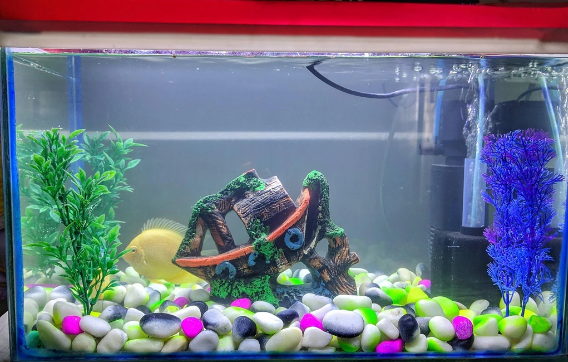Similar to Discus in terms of water parameters and temperament, Severum, aka Banded Cichlids, are quite popular in the aquarium trade. They have a relatively long lifespan and often exhibit interesting swimming behaviors. However, aquarists are mostly fascinated by their unique body shape, coloration, and patterns.
Severum cichlids are opportunistic feeders. While they mostly inhabit slow-moving river channels, They venture into flooded forests during the rainy seasons to take advantage of the increased availability of unclaimed territory and food. These dynamic behaviors not only showcase their adaptability but also make them more interesting to care for.
We’ll explore the optimum care conditions for your Severums and share more fun facts about this interesting South American species.
Table of Contents
Severum (Banded Cichlid) Overview
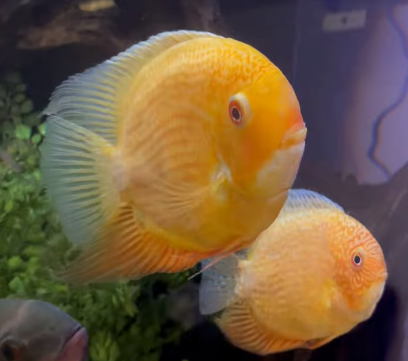
Severum or banded cichlids are freshwater fish native to various South American Countries like Venezuela, Peru, and Brazil. They Prefer warm and slightly acidic water with lots of submerged vegetation and hiding spots. These ecological preferences play critical roles in their well-being.
Here is a quick overview of the species before we jump into discussing their care routine in detail:
| Information Chart | Severum (Banded Cichlid) |
| Scientific Name: | Heros severus |
| Family: | Cichlidae |
| Care Level: | Moderate |
| Temperament: | Generally peaceful. Territorial during breeding. |
| Color: | Different colors and intricate patterns, including red, orange, green, and blue. |
| Lifespan: | 8 – 10 years |
| Size: | 8 to 10 inches |
| Diet: | Omnivorous. Commercial pellets, flakes, and frozen foods. |
| Minimum Tank Size: | 55 gallons for a pair |
| Temperature: | 76 to 82 F / 24 to 28 C |
| WaterConditions: | pH: 6.0 to 7.5Soft to moderately hard water |
| Tank Mate Compatibility | Larger, non-aggressive fish. Monitor tank dynamics during breeding. |
Severum (Banded Cichlid) Appearance
The appearance of Severum cichlids often varies depending on the specific species and selective breeding practices, but they typically share a few common characteristics.
Severums have a laterally compressed and oval-shaped body with elegant fins flowing along the top and bottom of the body. They boast a slick and streamlined body shape—suitable for quick escapes.
The base color of Severums is typically yellow, green, or gold, with darker bands, spots, and blotches covering their whole body, occasionally also the fins. They may also have species-specific vibrant markings adorning their body. For instance, Red-Shoulder Severums have a vibrant red band running along the back of their gills.
Varieties of Severum (Banded Cichlid)
A few Severum varieties are prevalent in the aquarium trade. Some of them include:
- Classic Banded Severum: The classic Severum with vertical bars on their olive green-yellow body. They may also have dark spots on their fins and orange flank.
- Red-Shoulder Severum: The largest Severum species, having iridescent blue markings on their body and a bright red patch on their shoulder. They can grow up to 10 inches in captivity.
- Gold Severum: A stunning variety of Severum of bright yellow body and few to no markings. Gold Severums are usually captive-bred and are designed to be as minimal as possible.
- Turquoise Severum: A large, turquoise variety of Severum with dark vertical bands on their body. They also showcase blue highlights on their fins and the back of the body.
Lifespan of Severum (Banded Cichlid)
Severum cichlids can live for 8-12 years in captivity with proper care and nutrition. In the wild, however, they have a lower life expectancy. To ensure a long and healthy life for your Severums, here are a few factors that you must maintain:
- Stable water parameters: Stable and optimum pH level, water hardness, ammonia level, nitrite level, and water flow rate can positively influence the lifespan of your beloved Severums.
- Adequate tank size: Severums are active explorers and eaters. If you’re really taking care of them, they can grow to massive sizes, and they also produce a lot of bioloads. Therefore, ensuring a spacious tank is essential for them to thrive.
- Proper decor: Severum cichlids need plenty of hiding space to feel comfortable and reduce stress, which can strengthen their immune system.
- Nutrition: Proper nutrition is essential for Severum Cichlids to grow to their potential size.
We’ve discussed all these factors in more detail in the subsequent sections.
Severum (Banded Cichlid) Size
Depending on the species, some Severum cichlids can grow up to 10 inches in captivity. However, their full growth potential is only unlocked through proper care and nutrition. Overcrowding is also a factor that negatively contributes to the size of Severums. Over-competition for food often leads to malnutrition and stunted growth in most fish species.
Some breeds of Severum are genetically bred to be larger than others, including the Red-Shoulder Severums we mentioned earlier. Inbreeding may also introduce genetic defects—shunting their growth and causing health issues.
Moreover, parasitic infections can drain a fish’s energy and resources—preventing it from reaching its full-size potential.
Severum (Banded Cichlid) Care & Tank Set-Up
Tank set-up, including tank size, dimensions, filters, water parameters, and tank landscape, is extremely necessary for the well-being of your Severum cichlids. Let’s delve into a detailed discussion of the same.
1. Severum (Banded Cichlid) Tank Size and Specifications
In addition to Severum cichlids being considerably large, they become pretty territorial during the breeding seasons. In a larger tank, as it’s advised for Severums, they can establish their own territories and avoid aggression and stress.
As mentioned, they also produce a lot of bioloads. This is essentially fish poop and can increase ammonia concentration in smaller tanks without proper filtration and water change routine.
Moreover, well-decorated tanks with lots of natural plants and hiding spots provide a more enriching environment for your Severums.
Optimum Tank Size for Severum (Banded Cichlid)
A minimum 55-60 gallon tank is adequate for a pair of Severum cichlids. If they’re being kept in a community setup with different species, larger tanks are required. However, you may keep your Severums in as large tanks as you may seem feasible as long as you’re providing enough hiding spaces and filtration.
A community of Severums, preferably a group of six, should be kept at least in a 150-gallon aquarium to minimize aggressions and reduce stress. Additionally, I would probably choose male/female pairs that get along to be in the tank.
Tank Shape for Severum (Banded Cichlid)
Generic rectangular tanks are considered well-suited for Severum Cichlids. Curved tanks, especially larger bow-fronts and half-cylinders, also work pretty well. In terms of swimming space, longer tanks are generally better than taller tanks.
A few tank sizes and their associated dimensions are mentioned here:
- 55 gallons: 48” x 13” x 21”
- 75 gallons: 48” x 18” x 21”
- 125 gallons: 72” x 18” x 21”
- 150 gallons: 72” x 18” x 28”
When sourcing larger aquariums, ensure that you have a table/stand sturdy enough to bear their filled weight of 1000-2000 lbs.
Filter Type
Severums are moderately active species and have a moderate appetite. They are neither voracious eaters like some cichlid species, nor do they survive on minimal nutrition. Moreover, as they have an omnivorous diet, they release a significant amount of bioload in the tank.
Depending on the number of fish and tank size, you need a powerful filtration system that can eliminate organic particles and reduce ammonia levels in your Severum tank.
Canister filters are pretty well-suited for that purpose. But you may also incorporate internal filters and HOB filters into your setup if you have a significantly larger tank.
For enhanced biofiltration—promoting the growth of beneficial bacteria—consider introducing sponge filters into your setup.
Substrate
In the wild, Severums inhabit slow-moving rivers and their tributaries with soft sand and muddy substrate. They often sift through the river beds as a fun activity and to find food. Providing them with a similar substrate emulates their natural environment and helps them maintain their natural habits. A few well-suited substrate choices may include:
- Fine Sand: One of the most optimum substrate choices for Severums. They’ll be able to find leftover food and redecorate the substrates pretty easily. Fine sand also helps maintain a stable water temperature. However, plants without strong roots may not grow on fine sand.
- Medium-Grained Sand: Medium-grained sand retains the benefits of fine sand but makes it a bit challenging for the Severums to practice their digging behavior. However, it provides more support for rooted plants.
- Soil and Sand: If you’re planning on a planted Severum tank, this combination of aquarium soil and sand is most similar to the natural environment of Severums. It also helps the plants anchor better. For best results, consider laying the soil beneath a thin layer of fine sand.
How Many Severum (Banded Cichlid) in 55 Gallon Tanks?
A pair of Severum cichlids can live in a 55-gallon tank. A group of Severum cichlids (6 individuals) can live in a 150-gallon tank.
2. Water Parameters for Severum (Banded Cichlid)
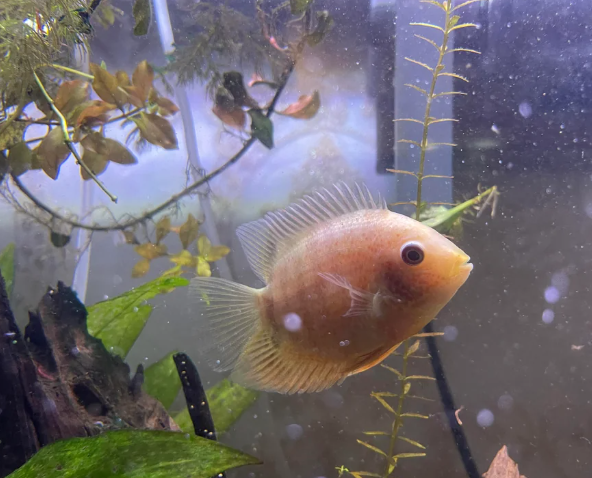
Sustaining an optimal water parameter is critical for the survival of Severum cichlids, for they are quite sensitive to changes in their environment. A few key water parameters that you need to consistently check and take reasonable actions to maintain are:
Water Temperature
Severums thrive in warmer water, typically in the range of 76 to 82° Fahrenheit or 24 to 28° Centigrade. Being cold-blooded creatures, Severums can’t produce heat in their body, and their metabolic functions are dependent on the temperature of their environment. Therefore, you need to maintain the temperature range for their overall well-being.
For those in colder regions,
- Use submersible aquarium heaters with sufficient wattage for your tank size (5 watts minimum per gallon). Position the heater where there is enough water flow, ideally near the filter outlet, for better circulation.
- Add an insulation layer around the sides and back of the tank. It can help retain heat and increase water temperature. Common insulating materials may include bubble wrap, foam panels, and aquarium-specific kits.
- Cover the top with a lid to reduce evaporation and trap heat. However, ensure that the lid has ventilation.
For those in extremely warm climates,
- Increase evaporation by raising water flow near the water surface.
- Keep the tank in the shade and plant natural trees in the tank.
- Use cool pads if the water temperature hits dangerous levels.
- Water changes can swiftly reduce water temperature.
Water Flow Rate
Inhabiting slow-moving rivers, Severums prefer calmer water compared to some other cichlids. They thrive in gentle to moderate water flow of 3-4 times the tank size in gallons per hour (GPH). For example, if you have a 55-gallon tank, a flow rate of 200-250 GPH should be adequate.
However, depending on their behavior, you may adjust the flow rate to suit individual fish better.
pH Level
The optimal pH level for Severums or Banded Cichlids is slightly acidic, 6.0 to 7.5. Here’s how to maintain it:
- Regularly monitor the pH and perform water changes.
- Don’t do massive water changes frequently to avoid pH dips or spikes.
- Crushed corals and aragonite act as natural pH buffers and help maintain the pH levels.
- Commercial pH buffering solutions are available.
- Proper surface agitation promotes gas exchange and helps maintain pH levels.
- Use pH increasers and decreasers carefully to achieve a desired pH level.
A suboptimal pH level can introduce several issues to Severums, including stress, respiratory issues, and behavioral abnormalities.
Water Hardness
Severums thrive in soft water, having a water hardness level between 5 to 10 dGH. Water hardness levels can be maintained by:
- Using RO/DI water during water change to reduce water hardness.
- To increase GH, add mineral additives.
- To increase KH, add baking soda or alkalinity buffers carefully. To decrease KH, introduce almond leaves in the tank.
3. Severum (Banded Cichlid) Tank Landscape
Plants and decorations are pretty critical for sustaining a Severum tank. Let’s discuss the key landscaping elements that promote a healthy ecosystem for Severum cichlids.
Best Plants for Severum (Banded Cichlid)
Severums often munch on “tasty” plants as a part of their diet. While this may be a necessary practice in the wild, ideally, they’ll be getting enough nutrition without it in your tank. Therefore, the best plants for Severums include:
- Amazon Sword
- Anubias
- Java Fern
- Cryptocoryne
- Water Wisteria
- Floating Duckweed
- Frogbit
Worst Plants for Severum (Banded Cichlid)
Delicate plants, including Cabomba or Riccia moss, are absolutely ill-suited for Severums as they’re likely to be devoured by them.
Plants with nutritional value, such as spinach and lettuce, also aren’t safe from Severums for obvious reasons.
As your Severums may nibble on them, do also avoid toxic plants like Amazon Tiger Lotus or Vallisneria.
Decorations for Severum (Banded Cichlid)
Plenty of hiding spots can distract Severums from nibbling on plants. A few of the options include:
- Driftwood
- Ceramic caves
- Complex rock patterns
Avoid sharp decorations, and don’t overcrowd the aquarium. Let your Severums explore the decorations, but leave enough space for them to swim and perform other activities.
Lighting for Severum (Banded Cichlid) Tanks
Severums don’t have a high-light requirement like plants or corals, but they require moderate lighting to maintain health, behavior, and overall well-being. Consider moderate intensity lighting of 2-3 watts per gallon of tank volume for best results and try to maintain a day-night cycle to promote a healthy sleep pattern.
When setting up the lighting, do go for the full-spectrum lighting options, as they can improve plant growth and fish health.
Feeding Severum (Banded Cichlid)
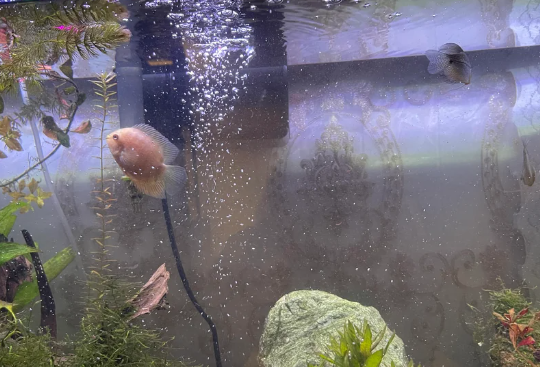
Severums rely on an omnivorous diet of small crustaceans and plant matter in the wild. But, you need to offer them a more balanced diet to sustain their good health, maximize their lifespan, and unlock their growth potential.
Best Diet for Severum (Banded Cichlid)
High-quality pellets or flakes, especially those exclusively made for cichlids, should form the foundation of your Severums’ diet. In addition to it, regularly offer them blanched zucchini, spinach, lettuce, and other greens rich in fiber and vitamins.
In case you’re in the mood to spoil your Severums, you may introduce occasional live/frozen brine shrimp, bloodworms, and chopped prawns. However, Severums are more reliant on greens than meat, so consider these as rare treats.
How often should you feed Severum (Banded Cichlid)?
Being opportunistic feeders, Severums often end up being overfed in artificial waters. Offer them 2-3 small meals throughout the day instead of one large serving. Aim to give them only what they can eat in a 2-3 minute window to prevent overfeeding and leftovers impacting the water quality.
Severum (Banded Cichlid) Tank Mates
If you’re considering community tanks with different fish species, you need to know the suitable tank mates for Severums. Here is a quick overview of the ideal and bad tank mates for Severum cichlids.
Ideal Severum (Banded Cichlid) Tank Mates
The ideal Severum tank mates are:
- Congo Tetra (Phenacogrammus interruptus)
- Buenos Aires Tetra (Hyphessobrycon anisitsi)
- Diamond Tetra (Moenkhausia pittieri)
- Corydoras Catfish (Various species)
- Angelfish (Pterophyllum scalare)
- Silver Dollar (Metynnis spp.)
- Rainbowfish (Melanotaenia spp.)
- Bristlenose Pleco (Ancistrus spp.)
- Raphael Catfish (Platydoras armatulus)
Bad Tank Mates for Severum (Banded Cichlid)
While Severums are generally peaceful, certain fish species aren’t suitable to be kept in the same tank.
Aggressive cichlids top the list, with most of them having a territorial nature and heightened aggression during breeding seasons.
Small and timid fish may get intimidated or preyed upon by Severums. Avoid keeping them in community tanks.
Very fast-moving fish species that may dart around may stress the Severums. Also, avoid fin-nipping fish species like barb.
Moreover, avoid species that are bottom-dwellers and may compete for hiding spots, such as certain types of catfish.
Severum (Banded Cichlid) Common Diseases and Their Treatment
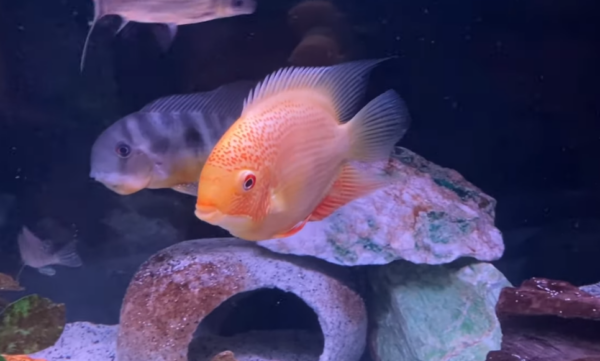
Similar to most aquarium fish species, Severums also are susceptible to a few common parasitic and bacterial diseases.
Ich
Symptoms of ich include the presence of white cysts resembling grains of salt on the skin, fins, and gills, with affected fish possibly exhibiting signs of rubbing against objects.
To address this parasitic infection, increase the aquarium temperature to expedite the life cycle of the parasite. Administer an ich medication containing formalin or copper. If possible, quarantine the affected fish to prevent the spread of the infection to other tank inhabitants
Also Read: Natural Ways Of Treating Ich
Fin Rot
Symptoms of fin rot include the deterioration of fins with frayed edges and discoloration. In severe cases, it may also affect the body.
To address this condition, focus on improving water quality with consistent water changes. Consider using a broad-spectrum antibiotic, such as erythromycin or tetracycline, as part of the treatment options.
Columnaris
Symptoms of Columnaris include the presence of white, thread-like lesions on the skin, fins, and gills, often resembling a fuzzy growth.
Treatment options include employing antibiotics such as erythromycin, tetracycline, or kanamycin. Additionally, try to quarantine affected fish to curb the potential spread of the disease to other tank inhabitants.
Facts about Severum (Banded Cichlid)
- Severums are known for vibrant colors like green, gold, and red spots.
- They are popular members of the diverse cichlid family.
- These majestic fish are excellent parents. They actively guard and care for their fry.
- Selective breeding has resulted in variations like Gold Severums and Red-Spotted Severums.
- With a lifespan of 10 to 15 years, they thrive on a diet of both animal and plant matter.
- Exhibiting territorial behavior, Severums appreciate a well-decorated tank with hiding spots.
- Severums coexist well with tetras and catfish in a properly maintained aquarium.
Are Severum (Banded Cichlid) Right for You?
Severums are right for you if you have the means to maintain larger tanks, including maintenance of water parameters, filtration, water change routines, and feeding. Although friendly, they’re a demanding species and reward those who can give proper care.
FAQs
You can put peaceful cichlid species, tetras, and some catfish species with Severums.
No. Guppies can’t live with Severums as the former may get swallowed by the larger Severums.
Gold Severums can live up to 10 years in captivity with proper care.
The Bottom Line
We’ve discussed the tank setup, feeding, tank landscape, and all other key elements of Severum care. Hopefully, you’ll now be able to take proper care of your banded cichlids and give them a happy and long life.
No related posts.

